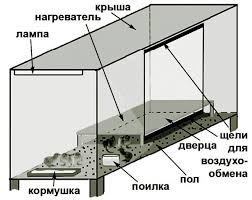Content:
Today many people start a household in order to have natural foods in their diet. One of the easiest to care for and affordable residents of the courtyard are chickens, which are purchased as chicks and raised for meat or eggs. However, few people know how to care for chickens.
What do chickens look like?
The chicken of the first month of life is yellow, with a red beak and beady eyes. Feathers grow with age, height and weight increase.
The shell protects the embryo from external damage. Although it seems fragile enough, it cannot be broken at once. Chicken requires calcium salts to form it. With a careful study of the shell, pores can be found in it through which the embryo breathes. The embryo begins to develop when the egg from the egg enters the hen's oviduct. As soon as it was carried by the laying hen, the future chick stops developing. In order for the embryo to continue to develop, a temperature of 40 ° C is needed. In the incubator, it is constantly supported without effort, the hen also does not experience difficulties when incubating, but at home it is difficult to withstand such a regime.
As soon as the chick hatches, it can already stand firmly on its feet. The chicken is covered with yellow down.
Chick care rules
The first month of life is extremely important for raising chicks.
Features of care in the first week of life
You need to prepare for the appearance of chicks in advance. The first step is to prepare a place for them. It should be spacious so that the chicks do not trample each other, and also reliably protected from drafts, because a certain temperature is required for keeping the chickens. It is recommended to install a lamp for heating and lighting. You can use conventional incandescent bulbs for this, but infrared is ideal.
The chicks should be kept at a temperature of 29-30 ° C at all times. For the first week, the lamp should work around the clock, as the chicks still need constant lighting. After 5 days, you can gradually reduce the temperature to 18 ° C. If the chicks behave actively and eat well during the temperature drop, everything is in order. If they huddle in a corner, hugging each other, you need to adjust the temperature regime for the chickens: raise the temperature and begin to lower it after 7 days. Only observation will tell you how long you need to keep the chickens under the lamp.
A brooder is an ideal place for first month chicks.
But if this is not the case, a regular box will do. In the early days, paper or a soft cloth should be placed on the bottom of the container, which should be changed every day. Chick litter should not be overly damp, but dryness will not be beneficial either. By the end of the week, birds should, if possible, be transplanted into a cage with a fine-mesh floor. This way, they won't get dirty in their droppings and care will be easier.If there is no such cage, you can cover the bottom of the box with hay, straw or sawdust, but, again, do not forget to change the litter periodically.
The place of keeping must meet certain requirements - 1 m² for 25-30 chicks. Otherwise, birds can peck at each other or trample.
The food must be strictly age appropriate for the chicks. It will not be superfluous to give feed additives and vitamins, but their correct choice is important, especially for broiler chicks.
The first feeding should be approached with all responsibility, because it starts the digestive system of the chickens. Feed should be given within 12-16 hours after the chick is born. The ideal first course is corn grits. It needs to be poured onto the bedding so that the chicks learn to peck on their own.
In addition to cereals, babies need water. Some breeders give a weak solution of potassium permanganate as a drink, but this should not be done. The chick's food system is absolutely sterile anyway. Ordinary purified water will do; you can use a glucose solution. This is the only thing that will benefit the chicks.
When the day has passed, other cereals can be added to the chicken diet:
- wheat;
- barley;
- semolina;
- millet.
Boiled egg yolk will be useful for chicks, but in small quantities. You can also add cottage cheese to the feed to replenish the body with protein and calcium, and as a drink - fermented milk products (whey).
From day 3, greens are added to the feed, from 5 - green onions, and week-old chickens can be given grated potatoes or carrots. During this period, it is worth regularly checking the goiter of each chick, it must be complete. If there are chicks with empty goiter, they must be transplanted and fed separately.
Features of care from the second week of life
When can chickens turn off the lights at night? From two weeks of age, you need to gradually reduce daylight hours. As a result, a week needs to be reduced to 9 hours. This means that the lamp can no longer be turned on. It is better to start the contraction during the day, as the gaps will initially be small. But when the day is 9 hours, then the chickens can turn off the light at night.
It is much more important to pay attention to nutrition, as it changes as the chick matures. From the second week, keeping chickens becomes much easier. Food can be served only 6 times a day. The diet remains the same, the only thing that changes is this amount. More feed is now needed. If initially the calculation was 10 g for each chicken, now it should be 20-25 g.
Three-week-old chicks can be stopped at night and reduced to 4 meals per day. Whole grains should not be given yet, but fermented milk products and cottage cheese can already be excluded from the diet. Grooming in the third week is more like keeping adult chickens. If the outside temperature is favorable, the chicks can be taken for a walk. However, if it is cold outside, you may not do this for up to 2 months.
Features of caring for monthly chicks
Monthly chicks should be transferred to an open-air cage with a roof, preferably closed from drafts. It is already possible to introduce specialized feed for chickens. It is strictly forbidden to give earthworms, as chickens can get sick from them. Coarse grains can be added to the meal, which must be mixed with the main feed. Also, freshly cut grass will not be superfluous or, if possible, let the chicks go for a walk in the clearing. Nutrition can be supplemented with a complex of vitamins intended for this age.
Features of caring for two-month-old chicks
The chicks are already quite strong, but this does not mean that they do not need careful care. The room should be well lit, warm, with sawdust or shavings on the floor. The size of the dwelling must meet these requirements - 1 m² for 16 individuals. At the age of 2 months, chicks must be released for walking. You need to feed such chicks 3 times a day at the same time. The diet should include grain flour, compound feed and wet mixes, as well as plain water. It is necessary to regularly clean the habitat, the feeder and the drinker.
Vaccinations for chickens at home
Vaccinations help to develop immunity in birds for certain diseases. It is better to vaccinate in a veterinary clinic, but if you follow a number of rules, you can do it at home.
Before starting vaccination, you need to know the epidemiological situation in the region. You should also pay attention to where the chicks are bred.
For vaccination you will need:
- a drug;
- cotton wool and liquid for sterilization;
- syringe (for subcutaneous and muscle injections) or pipette (for ocular administration);
- for a one-time grafting of livestock a sprayer;
- ice and distilled water.
Only healthy chicks should be vaccinated, as immunocompromised chicks may not survive the vaccination and may die.
The easiest way to get vaccinated is by eye or nose. The preparations are already sold with a dilution solution. However, care must be taken to keep the medicine cold. This vaccination is best done together.
For intramuscular injections, two people are also required. The needle should be inserted at an angle of 45 ° into the breast 2.5-4 cm from the keel bone.
If there are many chickens, spraying is the ideal vaccination option.
Within a week after vaccination, you need to closely monitor the condition of the chicks, some may experience complications.
Tips on how to properly care for your chickens at home
Many novice poultry farmers cannot cope with raising chicks. A large number of them do not live up to bottomhole age. Experienced poultry farmers advise to be well prepared before planting chickens. You need to read a large amount of literature, consult with experts, but all this does not replace practice. Only over the years will a breeder acquire the necessary skills to care for chickens at home.
The first month is extremely important. You need to carefully prepare the home, properly feed and monitor the condition constantly. After a month, leaving becomes easier, but still you can't relax. Even experienced ones at this time sometimes have questions, for answers to which they turn to other pros.
Is it possible to wash chicks
It's not uncommon for droppings to stick to the chicken's feathers. It needs to be washed off. If this is not done, the chick will not be able to empty its intestines and may eventually die. Chicks should be washed gently with warm water. After the dirt is washed off, you need to gently blot the wet area with a towel and place the chick in a warm place. The chicken should not freeze, otherwise it will catch cold and not survive.
Every breeder wants to have his own natural meat and eggs, but it is not always possible to grow everyone without loss. Only experience, gentle care and careful feeding will help to get by with small sacrifices. Taking care of chickens is not easy, but everyone can do it. There would be a desire!



















